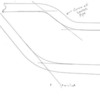quote:
Originally posted by Mangusta:
Bayani,
Wish I still had clean access to my tubes....would give it a shot at measurements! Actually got Erica running again today! Runnin....not yet drivin....!
Anyway, I thought there was only one hose up front which needed to be stretched just a hair to fit a 3/4?" fitting on the heater core. (???)
The other side went to the valve, which was slightly under 5/8" if I recall.
I recall sitting in the car staring at this going...."one's too small...the other is too big"...."what's up with that???"
Neat pic's of the tunnel! I have no idea what the engine end of things looks like, in terms of access thru that area of the tunnel....but if you could put the 90 degree bends on that end...and still get them thru the tunnel (engine out most likely???)..and being stainless, would be fantastic! A sure fire thing to do ....next time engine is pulled.....!
Since you will have unique pieces for the left and right tubes.... the 90's would likely need to be "nested" to cleanly make the corner and still allow hoses to connect properly, you could have the one tube that needs 3/4" to match.... you have the one end stretched slightly to 3/4"??? Thinking out loud.....
Love the chassis pic! So those two ears at the top with the holes in them are NOT supposed to be bent forward over the edge of the valance? Hmmmm!!!!
Ciao!
Steve
Thanks Steve,
Actually, the heater core on my '72 looks like it's metric. One was, like you said, slightly above 5/8" more like 16mm) and the end on the heater valve is slightly under under 5/8" (more like 14mm. Is that right?). I'll have to re-measure again to make sure before I commit to swagging or crimping the ends of the heater tubes I'm making.
The real challenge is making the 90s on the engine side. As you said, trying to "nest" the two bends will require the 90 on the driver side to angle up or down, depending on space, then back so it will be parallel to 90 on the passenger side tube. And yes, this is definitely an engine out service.
On my car, The actual tubes to the heater core are 10mm (slightly larger than 3/8") with one end brazed to a 16mm beaded tube fitting. The heater valve side had a female threaded fitting that, from what I read on another thread, to a 3/8"BPPT(British Parallel Pipe Thread?). The beaded tube fitting on the valve is about 18mm?. I wish I had the core out so I could change the ends. I really want to move the heater valve anyway, actually go to an electric heater valve mounted outside the cabin in the engine bay or under the front trunk (if I end up going with an under car heater tube arrangement.
Sorry, I'm just rambling on my ideas for this project. Bear with me here.





